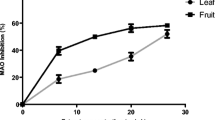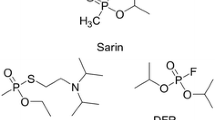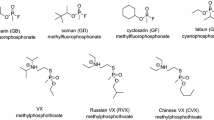Abstract
Thirteen pyrrolizidine alkaloids (PAs) 3′-acetylheliosupine, echihumiline, echihumiline N-oxide, echimidine, heliosupine, heliosupine N-oxide, heliotrine, monocrotaline, pycnanthine, retronecine, riddeline, senecionine, and seneciphylline) were analyzed for their interactions with acetylcholine-related enzymes, such as acetylcholine esterase (AChE), butyrylcholinesterase (BChE), choline acetyl transferase (ChAT), and neuroreceptors, such as α1- and α2-adrenergic, nicotinergic (nACh), muscarinergic (mACh) and serotonin2 (5-HT2) receptors. Whereas most PAs did not affect the enzymes, they show significant binding activities to mACh and 5-HT2 receptors: Twelve PAs exhibited a 50% inhibition of the specific binding of the radioligand [3H]quinuclidinyl benzilate (QNB) at the mAChR, i.e., IC50 values were between 8.7 μM and 512.5 μM, and 10 PAs exerted a 50% inhibition of the specific binding of the radioligand [3H]ketanserine at the 5-HT2R with IC50 values between 23.2 μM and 608.6 μM. The most active compound was 3′-acetylheliosupine, which was able to bind to all of the studied receptors with IC50 values in the range between 2.9 μM and 159.7 μM. The data imply that free PAs and PA N-oxides can affect several molecular targets: Besides long-term toxicity through DNA alkylation (by PA metabolites generated in the liver), liver and pneumotoxicity, neuroreceptors (among other molecular targets) may be modulated. The interference of PAs with neuronal signal transduction could mediate adverse physiological responses in herbivores and could thus contribute to chemical defense in plants and animals against herbivores and predators.
Similar content being viewed by others
REFERENCES
ATALC. K. 1978. Semisynthetic derivatives of pyrrolizidine alkaloids of pharmacodynamic importance: A review. Lloydia 41:315–326.
BERNAYSE. A., and R. F. CHAPMAN. 1994. Host-Plant Selection by Phytophagous Insects. Chapman & Hall, New York.
BILLERA.BOPPRÉM.WITTEL., and HARTMANNT. 1994. Pyrrolizidine alkaloids in Chromolaena odorata. Chemical and chemoecological aspects. Phytochemistry 35:615–619.
BOPPRÉM. 1990. Lepidoptera and pyrrolizidine alkaloids: Exemplification of complexity in chemical ecology. J. Chem. Ecol. 16:1–20.
BOPPRÉM. 1995. Pharmakophagie: Drogen, Sex und Schmetterlinge. Biol. Z. 25:8–17.
BROWNK. S., and TRIGOJ. R. 1995. The ecological activity of alkaloids, pp. 227–354in G. Cordell (ed.). The Alkaloids, Vol. 47. Academic Press, New York.
CHESNEYC. F. ALLENJ. R., and HSUI. C. 1974. Right ventricular hypertrophy in monocrotaline pyrrole treated rats. Exp. Mol. Pathol. 20:257–268.
DAMN. M. vanVERPOORTER., and MEIJDENE. van der. 1994. Extreme differences in pyrrolizidine alkaloid levels between leaves of Cynoglossum officinale. Phytochemistry 37:1013–1016.
DAMN. M. vanVUISTERL. W. M.BERGSHOEFFC.VOSde H., and MEIJDENE. van der. 1995. The “raison d'ètre” of pyrrolizidine alkaloids in Cynoglossum officinale: Deterrent effects against generalist herbivores. J. Chem. Ecol. 21:507–523.
DETZELA., and WINKM. 1993. Attraction, deterrence or intoxication of bees (Apis mellifera) by plant allelochemicals. Chemoecology 4:8–18.
EL-SHAZLYA.SARGT.ATEYAA.ABDEL AZIZE.EL-DAHMYS.WITTEL. and WINKM. 1996a. Pyrrolizidine alkaloids from Echium setosum and Echium vulgare. J. Nat. Prod. 53:310–313.
EL-SHAZLYA.SARGT.ATEYAA.ABDEL AZIZE.EL-DAHMYS.WITTEL. and WINKM. 1996b. Pyrrolizidine and tetrahydroisoquinoline alkaloids from Echium humile. Phytochemistry 42:225–230.
EL-SHAZLYA.SARGT.ATEYAA.ABDEL AZIZE.WITTEL. and WINKM. 1996c. Pyrrolizidine alkaloids of Cynoglossum officinale and Cynoglossum amabile (Family Boraginaceae). Biochem. Syst. Ecol. 24:415–421.
EL-SHAZLYA.SARGT.WITTEL. and WINKM. 1996d. Pyrrolizidine alkaloids from Cynoglossum creticum. Phytochemistry 42:1217–1221.
ELLMANG. L.COURTNEYK. D.ANDRESV., and FEATHERSTONER. M. 1961. A new and rapid colorimetric determination of acetylcholinesterase activity. Biochem. Pharmacol. 7:88–95.
FONNUMF. 1966. A radiochemical method for the estimation of choline acetyltransferase. Biochem. J. 100:479–484.
FONNUMF. 1975. A rapid radiochemical method for the determination of choline acetyltransferase. J. Neurochem. 24:407–409.
GHODSIF., and WILLJ. A. 1981. Changes in pulmonary structure and function induced by monocrotaline intoxication. Am. J. Physiol. 240:H149–H155.
HABSH.HABSM.MARQUARDTH.RÖDERE.SCHMÄHLD., and WEIDENFELDH. 1982. Carcinogenic and mutagenic activity of an alkaloidal extract of Senecio nemorensis spp. fuchsii. Arzneim. Forsch. 32:144–148.
HARBORNEJ. B. 1993. Introduction to Ecological Biochemistry, 4th ed. Academic Press, London.
HARTMANNT., and WITTEL. 1995. Chemistry, biology and chemoecology of pyrrolizidine alkaloids, pp. 155–233in S. W. Pelletier (ed.). Alkaloids: Chemical and Biological Perspectives, Vol. 9, Elsevier Science, Oxford.
HILLIKERK. S.BELLT. G., and ROTHR. A. 1982. Pneumotoxicity and thrombocytopenia after single injection of monocrotaline. Am. J. Physiol. 242:H573–H579.
HINCKSJ. R.KIMH. Y.SEGALLH. J.MOLYNEUXR. J.STERMITZF. R., and COULOMBER. A. JR., 1990. DNA cross-linking in mammalian cells by pyrrolizidine alkaloids: structure-activity relationship. Toxicol. Appl. Pharmacol. 111:90–98.
HOLZINGERF. and WINKM. 1996. Mediation of cardiac glycoside insensitivity in the monarch butterfly (Danaus plexippus): Role of an amino acid substitution in the ouabain binding site of Na+, K+-ATPase. J. Chem. Ecol. 22:1931–1947.
HOLZINGERF.FRICKC., and WINKM. 1992. Molecular basis for the insensitivity of the monarch (Danaus plexippus) to cardiac glycosides. FEBS Lett. 314:477–480.
HUXTABLER. J. 1979. Pyrrolizidine alkaloids and the lung endothelium: a paradigm of lung damage resulting from circulating toxins, pp. 43–56in P. R. Cheeke (ed.). Pyrrolizidine (Senecio) Alkaloids: Toxicity, Metabolism and Poisonous Plant Control Measures. Oregon State University, Corvallis.
HUXTABLER. J. 1990. Activation and pulmonary toxicity of pyrrolizidine alkaloids. Pharmacol. Ther. 47:371–389.
KAYJ. KEANEP. M.SUYAMAK. L., and GAUTHIERD. 1982. Angiotensin converting enzyme activity and evolution of pulmonary vascular disease in rats with monocrotaline pulmonary hypertension. Thorax 37:88–96.
LOWRYO. H.ROSEBROUGHN. J.FARRA. L., and RANDALLR. J. 1951. Protein measurement with the Folin phenol reagent. J. Biol. Chem. 193:265–275.
MANSTEINB. 1953. Senecion, ein uteruswirksames Mittel bei funktionellen Blutungen. Zentralbl. Gynaekol. 75:1672–1675.
MANSTEINB. 1959. Der Einfluss von Senecion auf die Gerinnungsfaktoren. Aerztl. Forsch. 13:32–34.
MASTERSA. R. 1991. Dual role of pyrrolizidine alkaloids in nectar. J. Chem. Ecol. 17:195–205.
MATTOCKSA. R. 1986. Chemistry and Toxicology of Pyrrolizidine Alkaloids. Academic Press, London.
MEIERB. 1994. Die Pestwurz-Stand der Forschung. Z. Phytother. 15:268–284.
MEYRICKB.GAMBLEW., and REIDL. 1980. Development of Crotalaria pulmonary hypertension: hemodynamic and structural study. Am. J. Physiol. 239:H692–H702.
MISERJ. S.SMITHONW. A.KRIVITW.HUGHESC. H. DAVISD.KRAILOM. D., and HAMMONDG. D. 1991. Phase II trial of indicine N-oxide in relapsed pediatric solid tumors. A report from the Children's Cancer Study Group. Invest. New Drugs 9:339–342.
MISERJ. S.SMITHSONW. A.KRIVITW.HUGHESC. H.DAVISD.KRAILOM. D., and HAMMONDG. D. 1992. Phase II trial of indicine N-oxide in relapsed acute leukemia of childhood. A report from the Children's Cancer Study Group. Am. J. Clin. Oncol. 15:135–140.
NICKISCH-ROSENEGKE.VONand WINKM. 1993. Sequestration of pyrrolizidine alkaloids in several arctiid moths (Lepidoptera: Arctiidae). J. Chem. Ecol. 19:1889–1903.
NICKISCH-ROSENEGKE.VONand WINKM. 1995. Influence of previous feeding regimes and ambient temperatures on degradation and storage of pyrrolizidine alkaloids in the moth species Creatonotos transiens (Lepidoptera: Arctiidae). Entomol. Gen. 19:157–170.
PETERKAM.SARINS.ROEDERE.WIEDENFELDH., and HALASKOVAM. 1994. Differing embryotoxic effects of senecionine and senecionine-N-oxide on the chick embryo. Funct. Dev. Morphol. 4:89–92.
POMEROYA. R., and RAPERC. 1971a. Pyrrolizidine alkaloids: Actions on muscarinic receptors in the guinea-pig ileum. Br. J. Pharmacol. 00:683–690.
POMEROYA. R., and RAPERC. 1971b. Pyrrolizidine aminoalcohols: Indirect cholinomimetic activity in guinea-pig ileum. Eur. J. Pharmacol. 14:374–383.
POOLB. L. 1982. Genotoxic activity of an alkaloidal extract of Senecio nemorensis ssp. fuchsii in Salmonella typhimurium and Escherichia coli systems. Toxicology 24:351–355.
ROEDERE. 1995. Medicinal plants in Europe containing pyrrolizidine alkaloids. Pharmazie 50:83–98.
ROSENTHALG. A., and BERENBAUMM. R. 1991. Herbivores. Their Interactions with Secondary Plant Metabolites, 2nd ed. Academic Press, San Diego.
ROSENTHALG. A. and BERENBAUMM. R. 1992. Herbivores. Their Interactions with Secondary Plant Metabolites, 2nd ed. Academic Press, San Diego.
ROTHSCHILDM. 1972. Secondary plant substances and warning colouration in insects, pp. 59–83in H. F. van Emden (ed.). Insect/Plant Relationships, Vol. 6, Blackwell, Oxford.
ROTHSCHILDM.VON EUWJ., and REICHSTEINT. 1972. Some problems connected with warningly coloured insects and toxic defense mechanism. Mitt. Basler Afr. Bibliogr. 4:135–158.
SCHMELLERT.SAUERWEINM.SPORERF.WINKM., and MÜLLERW. E. 1994. Binding of quinolizidine alkaloids to nicotinic and muscarinic acetylcholine receptors. J. Nat. Prod. 57:1316–1319.
SCHMELLERT.SPORERF.SAUERWEINM., and WINKM. 1995. Binding of tropane alkaloids to nicotinic and muscarinic acetylcholine receptors. Pharmazie 50:493–495.
SCHMELLERT.LATZ-BRÜNINGB., and WINKM. 1997. Biochemical activities of berberine, palmatine and sanguinarine mediating chemical defence against microorganisms and herbivores. Phytochemistry. 44:257–266.
SCHNEIDERD. 1986. The strange fate of pyrrolizidine alkaloids, pp. 123–142in R. F. Chapman, E. A. Bernays and J. G. Stoffolano (eds.). Perspectives in Chemoreception Behaviour. Springer-Verlag, Berlin.
SCHNEIDERD.BOPPRÉM.ZWEIGJ.HORSELEYS. B.BELLT. W.MEINWALDJ.HANSENK., and DIEHLE. W. 1982. Scent organ development in Creatonotos moths: Regulation by pyrrolizidine alkaloids. Science 215:1264–1265.
SCHULTZEA. E., and ROTHR. A. 1993. Fibrinolytic activity in blood and lungs of rats treated with monocrotaline. Toxicol. Appl. Pharmacol. 121:129–137.
TAYLORD. L.NASHR.FELLOWSL. E.KANGM. S., and TYMSA. S. 1992. Naturally occurring pyrrolizidines: inhibition of a-glucosidase and anti HIV activity of one steroisomer. Antivir. Chem. Chemother. 3:273–277.
TURNERJ. H., and LALICHJ. J. 1965. Experimental cor pulmonale in the rat. Arch. Pathol. 79:409–418.
VALDIVIAE.LALICHJ. J.HAYASHIY., and SONNADJ. 1967. Alterations in pulmonary alveoli after a single injection of monocrotaline. Arch. Pathol. 84:64–76.
WAGNERJ. G.PETRYT. W., and ROTHR. A. 1993. Characterization of monocrotaline pyrrole-induced DNA cross-linking in pulmonary artery endothelium. Am. J. Physiol. 264:L517–L522.
WIESSLERM. 1994. DNA adducts of pyrrolizidine alkaloids, nitroimidazoles and aristolochic acid. I.A.R.C., Sci. Publ. 165–177.
WILSOND. W.SEGALLH. J.PANL. C.LAMEM. W.ESTEPJ. E., and MORIND. 1992. Mechanisms and pathology of monocrotaline pulmonary toxicity. Crit. Rev. Toxicol. 22:307–325.
WINKM. 1992. The role of quinolizidine alkaloids in plant insect interactions, pp. 133–169in E. A. Bernays (ed.). Insect-Plant Interactions, Vol. IV, CRC Press, Boca Raton, Florida.
WINKM. 1993. Allelochemical properties or the raison d'être of alkaloids, pp. 1–118in G. Cordell (ed.). The Alkaloids, Vol. 43. Academic Press, New York.
WINKM., and LATZ-BRÜNINGB. 1995. Allelopathic properties of alkaloids and other natural products: Possible modes of action, pp. 117–126in Inderjit, K. M. M. Dakshini, and F. A. Einhellig (eds). Allelopathy: Organisms, Processes and Applications. ACS Symposium Series 582, American Chemical Society, Washington, D.C.
WINKM., and TWARDOWSKIT. 1992. Allelochemical properties of alkaloids. Effects on plants, bacteria and protein biosynthesis, pp. 129–150in S. J. H. Rizvi, and V. Rizvi (eds.). Allelopathy: Basic and Applied Aspects. Chapman & Hall, London.
WINKM.LATZ-BRÜNINGB., and SCHMELLERT. 1997. Biochemical mechanisms responsible for allelopathic activities of alkaloidsin K. M. M. Dakshini and Inderjit (eds.). Allelopathy: Procedures and Processes. In press.
WINKM.MEISSNERC., and WITTEL. 1995. Patterns of quinolizidine alkaloids in 56 species of the genus Lupinus. Phytochemistry 38:139–153.
YAMAMURAH. I. and SNYDERS. H. 1974. Muscarinic cholinergic binding in rat brain. Proc. Nat. Acad. Sci. U.S.A. 71:1725–1729.
Author information
Authors and Affiliations
Rights and permissions
About this article
Cite this article
Schmeller, T., El-Shazly, A. & Wink, M. Allelochemical Activities of Pyrrolizidine Alkaloids: Interactions with Neuroreceptors and Acetylcholine Related Enzymes. J Chem Ecol 23, 399–416 (1997). https://doi.org/10.1023/B:JOEC.0000006367.51215.88
Issue Date:
DOI: https://doi.org/10.1023/B:JOEC.0000006367.51215.88




